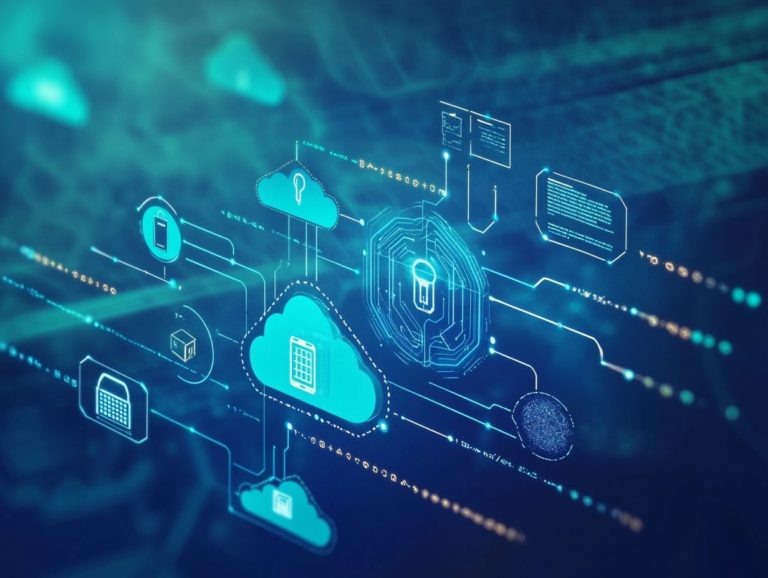The Role of DevSecOps in Cloud Security
In today s fast-paced digital landscape, the intersection of development, security, and operations often referred to as DevSecOps is becoming increasingly vital, particularly in the world of cloud computing.
As organizations embrace the cloud, they face unique security challenges. This article delves into the essence of DevSecOps and highlights its essential role in protecting cloud environments.
You ll discover best practices for implementation, confront common obstacles, and explore emerging trends that will shape the future of cloud security. Together, let s navigate this crucial framework for ensuring robust security in your cloud infrastructures.
Contents
- Key Takeaways:
- The Importance of Cloud Security
- The Role of DevSecOps in Cloud Security
- Implementing DevSecOps in Cloud Environments
- Future of DevSecOps in Cloud Security
- Frequently Asked Questions
- What is the role of DevSecOps in cloud security?
- How does DevSecOps improve cloud security?
- What are some common practices used in DevSecOps for cloud security?
- How does DevSecOps address the shared responsibility model in cloud security?
- What are the benefits of implementing DevSecOps in cloud security?
- How can organizations get started with implementing DevSecOps in cloud security?
Key Takeaways:

DevSecOps integrates security practices into the DevOps process, ensuring security is prioritized throughout the development lifecycle.
Cloud security is crucial for protecting sensitive data and preventing cyber attacks in cloud environments.
DevSecOps enhances cloud security by automating security processes, facilitating collaboration, and promoting a culture of security across teams.
What is DevSecOps?
DevSecOps is an integrated approach that combines development, security, and operations into a unified method aimed at improving your organization’s security throughout the software development lifecycle.
By embedding security practices into development processes, you can address security controls and vulnerabilities at every stage. This ensures compliance tracking and safe coding rules are consistently upheld.
Embracing this shift allows for swift responses to evolving threats while fostering a culture of continuous improvement and collaboration among development and security teams.
The core components of DevSecOps include automated testing, security metrics, and identity security practices.
Automated testing continuously vets your code for vulnerabilities before deployment, providing proactive defense against potential exploits. Security metrics serve as performance indicators, enabling informed decisions based on quantifiable data. Meanwhile, robust identity security gives you the power to manage access controls effectively, ensuring only authorized personnel interact with critical systems.
Together, these elements significantly enhance the agility and resilience of software development, making DevSecOps a critical framework in today s complex cybersecurity landscape.
The Importance of Cloud Security
In today s environment, where organizations heavily rely on cloud technologies, prioritizing cloud security is essential to protect sensitive data and comply with regulations like HIPAA and GDPR.
Navigating the transition to cloud environments presents unique security challenges that require sophisticated risk management strategies and tailored security policies.
This is crucial. Strong security practices can make all the difference in mitigating vulnerabilities and defending against threat actors increasingly targeting cloud applications.
Understanding Cloud Computing
Cloud computing transforms how you deploy and manage software applications, providing scalable resources and flexibility that empower you to tackle complex business challenges with innovative solutions.
By embracing cloud services, you streamline operations while accessing advanced security standards that protect your digital assets. This shift boosts operational efficiency but requires a solid understanding of the security implications and best practices necessary to safeguard sensitive data.
You can leverage various cloud service models, including:
- Infrastructure as a Service (IaaS): Lets you control virtual servers and storage.
- Platform as a Service (PaaS): Offers a platform for developing applications without managing underlying infrastructure.
- Software as a Service (SaaS): Delivers software over the internet, granting access from anywhere.
While these models present immense opportunities for agility and innovation, they also come with potential security risks. It’s essential to implement stringent security controls, such as encryption and regular access audits, to ensure you have adequate safeguards in place against vulnerabilities.
Security Risks in the Cloud
While cloud computing presents a wealth of advantages, it also brings with it a distinct array of security risks that you must navigate with care. As your organization increasingly relies on cloud services, vulnerabilities like data breaches, misconfigured settings, and weak access controls become serious threats to your sensitive information.
It s crucial for you to implement effective vulnerability management and threat modeling practices to mitigate these risks and ensure compliance with established security frameworks.
A report from IBM highlights that over 50% of organizations have faced at least one cloud-related security incident. This emphasizes the importance of being aware of these threats. Take the Capital One breach of 2019, for example, which exposed the personal data of more than 100 million customers due to a simple misconfigured firewall. This serves as a stark reminder of how critical robust security protocols are.
To address these vulnerabilities effectively, adopt detailed threat modeling methods that allow you to identify potential attack vectors and prioritize your resources accordingly.
Following well-recognized security frameworks such as NIST or CIS will provide you with structured guidance, enhancing your resilience against the ever-evolving threats in the cloud landscape.
The Role of DevSecOps in Cloud Security

DevSecOps serves as a cornerstone in strengthening cloud security by weaving security practices into every stage of the software development lifecycle. This proactive stance allows you to tackle vulnerabilities before they have a chance to be exploited.
By promoting collaboration among your development, security, and operations teams, you can establish a continuous software development lifecycle that responds adeptly to evolving threats. Automated testing becomes your ally in swiftly identifying potential gaps.
By integrating security seamlessly into each phase of development, you significantly bolster your cloud security measures and enhance your resilience against attacks.
How DevSecOps Addresses Cloud Security
DevSecOps tackles cloud security challenges by implementing comprehensive security metrics. This allows you to continuously monitor and enhance your security posture. By emphasizing identity security, you can establish robust access controls that effectively prevent unauthorized access to critical cloud resources.
This seamless integration of security into your daily operations ensures that compliance tracking is efficient and aligns with industry standards, ultimately reducing the risk of breaches and data loss.
Successful frameworks like the NIST Cybersecurity Framework demonstrate how organizations can effectively adopt these practices, showcasing tangible improvements in their security landscapes. By utilizing automated checks carried out by software without manual input, you significantly reduce overhead and ensure that your security protocols receive timely updates.
Frequent analysis of security metrics provides you with actionable insights, empowering your team to proactively address vulnerabilities. Real-world success stories illustrate how businesses not only meet regulatory requirements but also foster a culture of security, championing the protection of sensitive data while fortifying their cloud environments.
Implementing DevSecOps in Cloud Environments
Implementing DevSecOps in cloud environments requires you to adopt best practices that seamlessly foster collaboration while elevating security across teams, including understanding the role of threat intelligence in cloud security.
Make sure your organization prioritizes comprehensive security training, equipping your workforce with the skills needed to effectively address potential threats.
Furthermore, ensure that your incident management processes are robust and clearly defined, enabling your teams to respond swiftly to security incidents and minimize their impact on cloud operations.
Act now to strengthen your defenses and secure your cloud today!
Best Practices and Strategies
Adopting best practices in DevSecOps is essential for enhancing your cloud security and understanding the role of security information and event management in cloud to ensure that operations remain secure throughout the development lifecycle.
Key strategies include:
- Implementing threat modeling to identify potential vulnerabilities early on
- Encouraging teamwork among your development, security, and operations teams
This proactive approach not only mitigates risks but also elevates the overall security posture of your cloud applications and services.
By adding automated security checks to your development process, you can ensure that new code is scrutinized for security flaws long before it hits production.
Regular training sessions focused on security awareness empower every team member to recognize and address potential threats proactively.
Leveraging tools for continuous monitoring provides real-time insights into application behavior, further strengthening your security measures.
Regularly reviewing security incidents helps improve future strategies and nurtures an environment of continual learning and improvement.
Together, these methods create a resilient framework that supports a secure and agile cloud infrastructure.
Challenges and Solutions for DevSecOps in Cloud Security
The journey toward effective DevSecOps implementation in cloud security is often filled with challenges that you must navigate to safeguard your digital assets.
You may encounter common obstacles such as resistance to change, a lack of awareness, and the intricate task of weaving security into your existing workflows.
However, by recognizing these challenges and applying targeted solutions, you can significantly bolster your cloud security measures and enhance your compliance tracking with regulatory standards.
Common Challenges and How to Overcome Them

Common challenges in implementing DevSecOps often arise from inconsistencies in security policies across organizations, a lack of standardized processes, and insufficient automated testing frameworks.
To navigate these hurdles, establish clear security policies that align with the principles of DevSecOps. Invest in robust automated testing tools that enable continuous security assessments. This proactive approach allows you to identify vulnerabilities promptly and adjust your strategies effectively.
Cultivating a culture of collaboration among development, operations, and security teams is vital for dismantling silos and ensuring that everyone is aligned regarding security objectives. Regular training sessions can deepen your team’s understanding of security practices and tools, empowering them to foster a secure coding environment.
Integrating security into the CI/CD (Continuous Integration/Continuous Deployment) pipeline will enable you to catch issues early on, significantly reducing both risks and costs. By prioritizing these elements, you can streamline your DevSecOps implementation and build a more secure and resilient infrastructure. Don’t wait to secure your systems!
Future of DevSecOps in Cloud Security
The future of DevSecOps in cloud security is on the cusp of transformation, influenced by emerging technologies and trends designed to elevate security measures while optimizing development processes.
As you navigate this landscape, you’ll find that organizations are increasingly adopting artificial intelligence (AI) controls to automate threat detection and vulnerability management. Embracing machine learning within your DevSecOps practices will soon become a necessity.
This evolution not only enhances security but also cultivates a culture of innovation throughout the software development lifecycle.
Start implementing these strategies today to protect your digital assets!
Emerging Technologies and Trends
Emerging technologies are changing how we do DevSecOps. AI controls and advanced analytics are now critical for proactive cloud security.
By using these innovations, you can boost your security metrics. This helps streamline incident response and maintain compliance with industry standards.
As cyber threats grow, machine learning algorithms are changing how security teams identify and manage risks. These systems analyze large data sets to spot unusual activities quickly.
With advanced analytics, you can gain insights from your security data. This helps you predict potential breaches before they happen.
This proactive approach minimizes threat impacts. It also fosters continuous improvement in your security practices, adapting to today’s fast-changing cloud environments.
Frequently Asked Questions
What is the role of DevSecOps in cloud security?
DevSecOps integrates security into software development. In cloud security, it means adding security practices at every stage of cloud applications and infrastructure.
How does DevSecOps improve cloud security?

DevSecOps improves cloud security by shifting security earlier in the development process. This allows teams to detect and fix security issues sooner.
What are some common practices used in DevSecOps for cloud security?
Common DevSecOps practices for cloud security include infrastructure as code, automated vulnerability scanning, and ongoing monitoring.
The shared responsibility model means both the cloud provider and the customer must secure the cloud. DevSecOps provides tools for customers to protect their applications while working with providers to secure the infrastructure.
What are the benefits of implementing DevSecOps in cloud security?
Implementing DevSecOps leads to faster, more secure software delivery. It also enhances teamwork and compliance with regulations.
How can organizations get started with implementing DevSecOps in cloud security?
Organizations should start by identifying security needs. Integrating security practices and investing in developer training will also help ensure ongoing cloud security.






